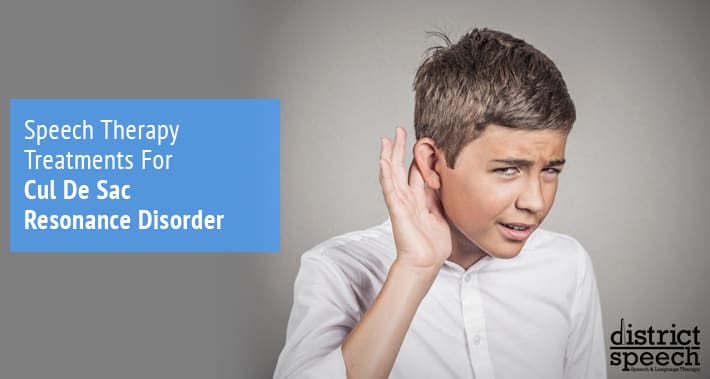
A cul de sac resonance disorder can impact the quality of your speaking ability.
If you’re wondering why you have trouble speaking at an appropriate volume or why your voice comes out sounding ‘trapped’, it may be due to a cul de sac resonance disorder.
Now, your speech therapist will want to conduct an speech therapy evaluation to determine the cause of your cul de sac resonance disorder in order to determine what type of treatment would best resolve this.
This is because speech therapy for resonance disorders like cul de sac is most effective for resonance disorders with functional or mis-learning causes.
But, we’ll find out more on this later.
Let’s get started by learning more about what exactly a cul de sac resonance disorder is.
What Is Cul De Sac Resonance Disorder?
A cul de sac resonance disorder is a type of resonance disorder that can affect the sound of your speech.
But first, it’s important to understand what a resonance disorder is.
There are many types of resonance disorders and they all result from either too much or too little nasal and oral sound energy during speech.
Examples of speech therapy for resonance disorders include:
As well, speech therapy for velopharyngeal insufficiency and speech therapy for cleft lip and cleft palate often focus on resonance as well.
This is because although these aren’t necessarily resonance disorders themselves, they often affect resonance.
Transgender voice training often focuses on resonance as well.
Resonance is one of the contributing factors to making your speech sound the way it does.
It’s the reverberation of sound in different parts of your body – usually your chest or head.
A cul de sac resonance disorder is the result of the transfer of sound produced by your vocal folds through your vocal tract.
Your vocal tract includes your larynx, pharynx, oral cavity, and nasal cavity.
Your vocal tract filters the sound produced by your vocal folds and selectively enhances the harmonics based on its shape and size.
Perceived resonance is the result of this process, which is when sound resonates in any part of your vocal tract, but cannot exit due to an obstruction.
This is why it sounds ‘trapped’ and why it’s called a cul de sac resonance disorder.
‘Cul de sac’ means ‘bottom of the sack’ and implies that you can’t leave the sack.
Cul De Sac Resonance Disorder Signs
The main signs that you might have a cul de sac resonance disorder include:
- Sound resonates in one of your vocal tract cavities but is blocked at the exit due to an obstruction
- Your speech sounds muffled and indistinct
- You speak at a low volume and can’t comfortably adjust this
- You could have a ‘tin like’ resonance and indistinct speech
Each of these symptoms vary depending on the severity of the condition and the obstruction that may be causing it.
What Causes Cul De Sac Resonance Disorder?
A cul de sac resonance disorder, like all resonance disorders, can have either structural or functional causes, or occasionally can be due to mis-learning.
Mis-learning can cause articulation errors that lead to the perception of a resonance disorder, but is not actually a resonance disorder because once you address your articulation, the issue tends to resolve itself.
A structural cause means that there is a structural obstruction and usually requires surgery to address.
This is the case with things like cleft palate.
Functional causes can usually be addressed with speech therapy because it’s about the function of your vocal tract and how it’s working, not a physical obstruction.
Some other causes of a cul de sac resonance disorder include:
- Velopharyngeal dysfunction
- Oronasal fistulas
- Nasal or pharyngeal cavity obstructions
- Hearing loss resulting in a lack of auditory feedback
- Oral microstomia, or having too small of a mouth opening
- Nasal blockages including polyps, stenotic nares, or a deviated septum
- Pharyngeal obstructions like swollen tonsils, or enlarged adenoids
Assessing For Cul De Sac Resonance Disorder
To assess for a cul de sac resonance disorder, your speech therapist will typically inspect your vocal tract.
Specifically, they’ll check to see if you have any obstructions in your oral, nasal or velopharyngeal function.
The goal of this is to see if you need speech therapy or a medical intervention like surgery or a prosthetic.
It’s recommended that you also receive an assessment from an audiologist to make sure that your cul de sac resonance disorder is not a perceived one due to hearing impairment.

How Can Speech Therapy For Cul De Sac Resonance Disorder Help?
Speech therapy is a great resource if the cause of your cul de sac resonance disorder is functional or due to mis-learning.
Your speech therapist will first conduct a thorough evaluation in order to create a personalized plan.
Tailored to you, this plan will maintain your strengths and address your weaknesses related to the underlying functions that are affecting your resonance and articulation.
Your plan will also consider your general environment and suggest modifications to your home, work, or school environments that can reduce barriers and facilitate better communication and participation from you.
The main goal here is for you to improve your resonance and articulation so that you can have functional speaking abilities.
Book Your Appointment With District Speech Today
Speech therapy can be highly effective to help improve your resonance and articulation.
This is especially the case if you have a cul de sac resonance disorder that is caused by mislearning or functionally.
District Speech has a team of highly trained speech therapists ready to help.
Book your appointment with District Speech to get started and schedule an evaluation today.
1300 I St NW, Suite 400 E,
Washington, DC 20005
- https://g.page/districtspeech
District Speech and Language Therapy specializes in speech therapy, physical therapy, and occupational therapy solutions, for both children and adults, in the Washington D.C and the Arlington Virginia areas.